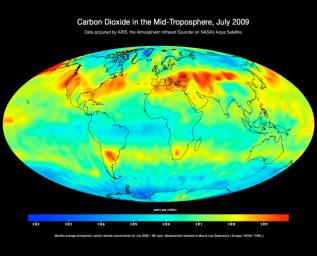This image was created with data acquired by the Atmospheric Infrared Sounder instrument (AIRS) on NASA's Aqua satellite during July 2009. The image shows large-scale patterns of carbon dioxide concentrations that are transported around Earth by the general circulation of the atmosphere. Dark blue corresponds to a concentration of 382 parts per million and dark red corresponds to a concentration of almost 390 parts per million. The northern hemisphere mid-latitude jet stream effectively sets the northern limit of enhanced carbon dioxide. A belt of enhanced carbon dioxide girdles the globe in the southern hemisphere, following the zonal flow of the southern hemisphere mid-latitude jet stream. This belt of carbon dioxide is fed by biogenesis activity in South America (carbon dioxide is released into the atmosphere through the respiration and decomposition of vegetation), forest fires in both South America and Central Africa, and clusters of gasification plants in South Africa and power generation plants in south eastern Australia.
About AIRS
The Atmospheric Infrared Sounder, AIRS, in conjunction with the Advanced Microwave Sounding Unit, AMSU, senses emitted infrared and microwave radiation from Earth to provide a three-dimensional look at Earth's weather and climate. Working in tandem, the two instruments make simultaneous observations all the way down to Earth's surface, even in the presence of heavy clouds. With more than 2,000 channels sensing different regions of the atmosphere, the system creates a global, three-dimensional map of atmospheric temperature and humidity, cloud amounts and heights, greenhouse gas concentrations, and many other atmospheric phenomena. Launched into Earth orbit in 2002, the AIRS and AMSU instruments fly onboard NASA's Aqua spacecraft and are managed by NASA's Jet Propulsion Laboratory in Pasadena, Calif., under contract to NASA. JPL is a division of the California Institute of Technology in Pasadena.
More information about AIRS can be found at http://airs.jpl.nasa.gov.

 Planetary Data System
Planetary Data System












